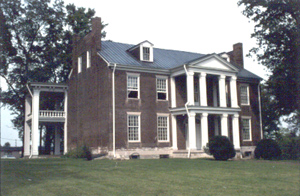
Carnton Plantation
The Carnton Plantation is a historic house museum located in Franklin. Randal McGavock (1768-1843), builder of Carnton, emigrated from Virginia in 1796 and settled in Nashville. He was involved in local and state politics and eventually served as mayor of Nashville, 1824-25. Around 1826 McGavock moved his family to the recently completed Carnton to farm and raise thoroughbred horses until his death in 1843. After his death, his son John inherited the plantation and continued to farm the land until his own death in 1893. The McGavocks grew wheat, corn, oats, hay, and potatoes, in addition to raising thoroughbred horses.
Randal McGavock named his property after his father’s birthplace in County Antrim, Ireland. The Federal-style plantation house became a social and political center where McGavock entertained Andrew Jackson and James K. Polk and presided over an estate that grew to 1,420 acres. For many years the main house was joined to the smokehouse by a two-story “wing,” that was actually the first structure on the site (ca. 1815). The “wing” was damaged by a tornado in 1909 and torn away soon after, though its outline remains clearly visible on the wall of the house.
In 1847 John McGavock added a two-story Greek Revival portico and two dormers in the attic just prior to his 1848 marriage to his cousin, Carrie Winder of Ducros Plantation in Louisiana. A few years later, the couple added a two-story porch onto the rear of the house, which extended at one end to take advantage of southerly breezes. The interior was also updated in the 1850s, with the addition of fashionable wallpapers, carpets, and paint. The central passage now appears much as it did during the Civil War years, with restored paint colors and an original wallpaper pattern reproduced from a fragment that remains in place at the top of the stairs. The parlor was upgraded by adding a Greek Revival mantel, new wallpaper, and wall-to-wall carpeting.
Following the battle of Franklin, November 30, 1864, the house became a Confederate field hospital. During the night following the five-hour battle, the McGavocks and their two children Hattie (age nine) and Winder (age seven) assisted the surgeons and tended to the needs of the wounded. Several hundred eventually came to Carnton and 150 died that first night. Bloodstains are still visible in several rooms. They are heaviest in the children’s bedroom, which was used as an operating room. The bodies of Confederate Generals Cleburne, Granbury, Strahl, and Adams were brought to Carnton’s rear porch and placed on its lower level awaiting removal to their final burial places. Most of the over 1,750 Confederate dead were buried on the battlefield, their graves marked by wooden headboards inscribed with the soldier’s name, company, and regiment. Over the months, the writing faded, and the markers began to disappear.
To preserve the graves, John McGavock designated two acres of land adjoining his family cemetery to which the remains could be removed for a more secluded and protected resting place. He, as well as other concerned Franklin citizens, raised the necessary money to have the bodies disinterred and reburied in order by state in the spring of 1866. The inscriptions on the grave markers, which had remained in place on the battlefield, were carefully preserved by Carrie McGavock in the Cemetery Record Book. The numbers on the present markers correspond to numbers in the book. John and Carrie McGavock cared for the McGavock Confederate Cemetery for the rest of their lives.
Winder McGavock lived at Carnton with his family until his death in 1907. His widow sold the house out of the family in 1911. The McGavock Confederate Cemetery has been maintained since then by the Franklin Chapter of the United Daughters of the Confederacy.
Carnton passed through several owners from the time it left the McGavock family until September 1978, when the Carnton Association acquired the house and ten acres and opened it as a historic site. Today, Carnton is listed on the National Register of Historic Places and designated a National Historic Landmark for its role in the battle of Franklin.



